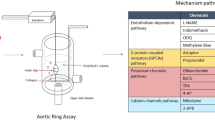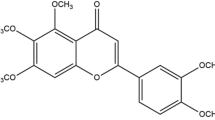Abstract
The soy-derived isoflavones genistein and daidzein affect the contractile state of different kinds of smooth muscle. We describe acute effects of genistein and daidzein on contractile force and intracellular Ca2+ concentration ([Ca2+]i) in in situ smooth muscle of rat aorta. Serotonin (5-HT) (2 μM) or a depolarizing high K+ solution produced the contraction of aortic rings, which were immediately relaxed by 20 μM genistein and by 20 μM daidzein. Accordingly, both 5-HT and a high K+ solution increased the [Ca2+]i in in situ smooth muscle cells. Genistein strongly inhibited the [Ca2+]i increase evoked by 5-HT (74.0±7.3%, n=11, p<0.05), and had a smaller effect on high K+ induced [Ca2+]i increase (19.9±4.0%, n=7, p<0.05). The K+ channels blocker tetraethylammonium (TEA) (0.5 mM) diminished genistein effects on 5-HT-induced [Ca2+]i increase. Interestingly, during prolonged application of 5-HT, the [Ca2+]i oscillated and a short (90 s) preincubation with genistein (20 μM) significantly diminished the frequency of the oscillations. This effect was totally abolished by TEA. In conclusion, in rat aortic smooth muscle, genistein is capable of diminishing the increase in [Ca2+]i and in force evoked by 5-HT and high K+ solution, and of decreasing the frequency of [Ca2+]i oscillations induced by 5-HT. The short time required by genistein, and the relaxing effect of daidzein suggest that tyrosine kinases inhibition is not involved. The small inhibiting effect of genistein on the [Ca2+]i increase evoked by high K+ and the effect of TEA point to the activation by genistein of calcium-activated K+ channels.
Resumen
Genisteína y daidzeína, dos isoflavonas presentes en la soja, afectan el estado contráctil de diferentes tipos de músculo liso. Describimos aquí efectos agudos de estos compuestos sobre la fuerza contráctil y la concentración intracelular de Ca2+ ([Ca2+]i) en músculo liso aórtico de rata in situ. La serotonina (5-HT) (2 μM) o una solución despolarizante de alto K+ produjeron la contracción de anillos de aorta de rata, que fueron relajados inmediatamente por genisteína (20 μM) y daidzeína (20 μM). En concordancia con esto, tanto la 5-HT como el alto K+ incrementaron la [Ca2+]i en células de músculo liso aórtico in situ. La genisteína inhibió el aumento de [Ca2+]i producido por 5-HT (74,0±7,3%, n=11, p<0,05) y tuvo un efecto menor sobre aquel debido al alto K+ (19,9±4,0%, n=7, p<0,05). El bloqueante de canales de K+ tetraetilamonio (TEA) (0,5 mM) disminuyó los efectos de genisteína sobre el aumento de [Ca2+]i debido a 5-HT. Durante la aplicación prolongada de 5-HT, la [Ca2+]i comenzó a oscilar y una preincubación corta con genisteína (90 s) disminuyó significativamente la frecuencia de estas oscilaciones, siendo este efecto totalmente bloqueado por TEA. En conclusión, en el músculo liso aórtico de rata la genisteína es capaz de atenuar el aumento de [Ca2+]i y de la fuerza inducidos por 5-HT, así como de disminuir la frecuencia de las oscilaciones en la [Ca2+]i. El corto tiempo requerido por la genisteína, así como la relajación inducida por daidzeína sugieren que esto no se debe a inhibición de tirosín quinasas. El menor efecto de genisteína sobre el aumento de [Ca2+]i debido al alto K+, así como los efectos del TEA apuntan a la inhibición por parte de genisteína de canales de K+ activados por Ca2+.
Similar content being viewed by others
References
Akiyama, T. and Ogawara, H. (1991): Methods Enzymol., 201, 362–370.
Akiyama, T., Ishida, J., Nakagawa, S., Ogawara, H., Watamabe, S., Itoh, N., Shibuya, M. and Fukammi, Y. (1987): J. Biol. Chem., 262, 5592–5595.
Chiang, C. E., Chen, S.A., Chang, M. S., Lin, C.I. and Luk, H. N. (1996): Biochem. Biophys. Res. Commun., 223, 598–603.
Florian, J. A. and Watts, S. W. (1998): J. Pharmacol. Exp. Ther., 284, 346–355.
Kuiper, G. G., Lemmen, J. G., Carlsson, B., Corton, J. C., Safe, S. H., Van der Saag, P. T., Van der Burg, B. and Gustafsson, J. A. (1998): Endocrinology, 139, 4252–4263.
Lee, M. Y. K., Leung, S. W. S., Vanhoutte, P. M. and Man, R. Y. K. (2004): Eur. J. Pharmacol., 503, 165–172.
Liu, H., Li, K. and Sperelakis, N. (1997): Can. J. Physiol. Pharm., 75, 1063–1068.
Liu, H., Li, K. and Sperelakis, N. (1997): Can. J. Physiol. Pharm., 75, 1058–1062.
Nelson, S. R., Chien, T. and Di Salvo J. (1997): Arch. Bioch. Biophys., 345, 65–72.
Nevala, R., Paukku, K., Korpela, R. and Vapaatalo, H. (2001): Life Sci., 69, 1407–1417.
Nicholls, J. A., Greenwell, J. R., Gillespie, J. I. (1995): Pflugers Arch., 429, 477–484.
Saini, H.K., Sharma, S. K., Zahradka, P., Kumamoto, H., Dhalla, N. S. and Takeda, N. (2003): Can. J. Physiol. Pharm., 81, 1056–1063.
Setchell, K. D. (2001): J. Am. Coll. Nutr., 20, 354S-362S.
Steusloff, A., Paul, E., Semenchuk, L. A., Di Salvo, J. and Pfitzer, G. (1995): Arch. Biochem. Biophys., 320, 236–242.
Washizuka, T., Horie, M., Obayashi, K. and Sasayama, S. (1998): J. Mol. Cell. Cardiol., 30, 2577–2590.
Wheeler-Jones, C. P. D., May, M. J., Morgan, A. J. and Pearson, J. D. (1996): Biochem. J., 315, 407–416.
Xiong, Z., Burnette, E. and Cheung, D. W. (1995): Eur. J. Pharmacol., 290, 117–123.
Yokoshiki, H., Sumii, K. and Sperelakis N. (1996): J. Mol. Cell. Cardiol., 28, 807–814.
Author information
Authors and Affiliations
Corresponding author
Rights and permissions
About this article
Cite this article
Speroni, F., Rebolledo, A., Añón, M.C. et al. Genistein inhibits contractile force, intracellular Ca2+ increase and Ca2+ oscillations induced by serotonin in rat aortic smooth muscle. J. Physiol. Biochem. 63, 143–151 (2007). https://doi.org/10.1007/BF03168225
Received:
Issue Date:
DOI: https://doi.org/10.1007/BF03168225




